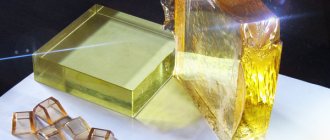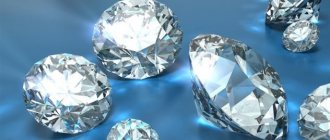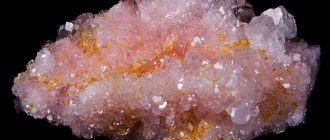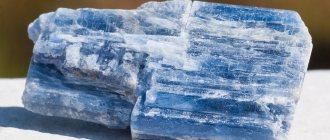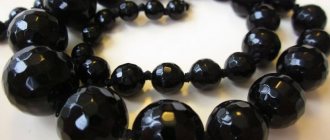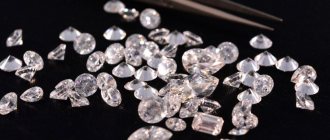During the natural processes of formation of the earth's crust or rock formations, spherical cavities are formed. In scientific language they are called geodes (from the Greek “geoda” - similar to earth).
In mineral mines, the internal cavity of the geode is filled with layers or crystals of gems, for which such formations are valued by jewelers and collectors.
Education mechanism
Most often, geodes form in sedimentary rocks or limestone. This is due to the mechanism of their formation:
- Under the influence of volcanic processes, cracks or cavities of rounded shapes constantly form in the bowels of the earth. The outer wall of such nodules may consist of silica, quartz, chalcedony, agate or chrysoprase.
- The structure is durable, but has small cracks.
- Groundwater flowing through such a cavity leaves a sediment of mineral salts.
- When a high concentration of minerals in the sediment is reached, crystallization begins.
- The large free space of the geode does not prevent the growth of crystals until they completely fill it.
The amethyst geode is especially famous for its beauty, from which both figurines and jewelry are made in Brazil and Uruguay. Due to the largest reserves of amethyst, geodes larger than a man are also found there.
Application area
Agate jewelry, amulets, carved seals, gems, figurines, vases and vessels were popular among ancient peoples around the world. Artifacts found by University of Cincinnati archaeologists in 2015 during the opening of a rich tomb in the Peloponnese included ivory combs inlaid with agates and a carved agate seal. The miniature drawing, skillfully carved on the surface of the stone seal, is a scene of a mythological or real battle. Some details of the image can only be seen under a microscope. A unique archaeological find challenges our understanding of the level of artistic excellence of the Aegean era.
During archaeological excavations in the City of David (the oldest area of Jerusalem), among the ruins of a temple burned during the conquest of the city by Nebuchadnezzar's wax, a seal was found, skillfully carved on an agate base. The estimated age of the archaeological find is 2600 years.
Beads, bracelets, brooches, cufflinks, earrings, rings, pendants, pendants - original jewelry with agates has been and will be popular at all times. A hard but viscous mineral with its unique, never repeating pattern, is used for mosaic panels, the manufacture of facing tiles, and countertops. Modern life is decorated with agate figurines, vases, boxes, business card holders, and key rings.
Homogeneous agates are in demand as a technical stone:
- in precision instrument making (for the manufacture of analytical balances, watch stones);
- in textile production (thread guides);
- for the manufacture of extrusion equipment (dies);
- for the manufacture of mortars and pestles, which are used in chemical analytical laboratories and artists' workshops.
What is a druse
A druse is an accreted aggregate of crystallized minerals (translated from German as “brush”). This name was given for the similarity of the shape of the crystals connected in a chaotic order in the cavity of the sphere with bristles.
The direction of the tops of the stones can also be oriented in one direction, then the nugget looks very impressive.
Even the fusion of just 2 gems together is equivalent to druses, and their size can be no more than a few millimeters.
Types of drusen
Based on the composition of the crystals and the base on which they rest, druses are classified as follows:
- Single-component. The formation of crystals occurs on a mineral of a similar composition. For example, lime spar stones grow on a base of the same spar, which has a granular structure.
- Multicomponent. The crystal is formed by one mineral, and the layer on which it is fixed is formed by another. Thus, quartz druse often forms on gold ore.
View this post on Instagram
Posted by Zhanara Serikkan (@art_serikkan) Jul 25, 2021 at 2:58 PDT
By form:
- Straight when the base has no irregularities.
- Curved, as in spherical cavities.
- A drusen is called a flower when the crystals grow from the center to the periphery of the cavity.
- A brush is a druse made up of small crystals growing in a vertical plane.
The size of a drusen can be either miniature - a few millimeters - or large.
Interesting! The largest druse is more than 2 m high and consists of rock crystal. Such an exhibit is kept in the Mining Museum of St. Petersburg.
Components of GIS
A working GIS has five key components: hardware, software, data, people, and methods.
Hardware.
This is the computer running the GIS. Today, GIS operate on different types of computer platforms, from centralized servers to stand-alone or networked desktop computers.
Software
A GIS contains the functions and tools needed to store, analyze, and visualize geographic (spatial) information. The key components of software products are: tools for entering and manipulating geographic information; database management system (DBMS or DBMS); tools to support spatial queries, analysis and visualization (display); graphical user interface (GUI or GUI) for easy access to tools and functions.
Data.
This is probably the most important component of GIS. Spatial location data (geographic data) and associated tabular data may be collected and produced by the user or purchased from vendors, commercially or otherwise. In managing spatial data, a GIS integrates spatial data with other data types and sources, and can also use the DBMSs used by many organizations to organize and maintain the data they have.
Performers.
Widespread use of GIS technology is impossible without people who work with software products and develop plans for using them to solve real problems. GIS users can be both technical specialists who develop and maintain the system, and ordinary employees (end users) to whom GIS helps solve everyday affairs and problems.
Methods.
The success and efficiency (including economic) of using GIS largely depends on a properly drawn up plan and work rules, which are established in accordance with the specific tasks and work of each organization.
Differences between a geode and a druse
In mineralogy, geodes are any cavities in a rock filled with a mineral. The formation of such a formation is called secretion, since most often the gems penetrate into the rock, seeping through the walls along with water.
The mineral components inside the geode can either crystallize or be layered on the walls. The combined pattern of a layered pattern on the walls and crystals in the center looks beautiful.
Unlike druses, geodes are always multicomponent. The cavity itself is formed by the rock due to ruptures, cracks or solidification of gas bubbles. And minerals get inside when the geode comes into contact with groundwater, which brings with it microparticles of gems.
If a mineral crystallizes inside a closed cavity, then the formation will no longer be called a druse, but a geode.
Types of geodes
Geologists distinguish between types of geodes depending on the mechanism of crystallization of minerals:
- Recrystallized geodes. Their peculiarity is that under the influence of changing external conditions, already formed crystals dissolve. This solution is washed with thermal waters to remove excess impurities. Then the drusen begins to crystallize again from the concentrate. As a result, the body of the mineral turns out to be transparent, without suspensions or inclusions.
- Limonite. Formed in iron ore rock. In cavities or cracks, when water enters, oxidative processes occur that form geodes.
- Silica. Found in quartz limestone cavities. Most often it forms a druse - a brush of gemstones.
- Metosomatic geodes. A subject of study for scientists, as they represent the process of replacing one mineral with another inside a cavity.
- Ferromanganese. A promising object of study, as they are located on the ocean floor.
By size, geodes less than 1 cm are distinguished - tonsils.
View this post on Instagram
Publication from Elena Dobrovolskaya (@dobrolen.khv) July 25, 2021 at 12:13 PDT
Adviсe
- You can also occasionally tap the stone to see if it is a geode. Geodes sound hollow because they have crystals inside.
- Take your surroundings seriously and never go mineral hunting, prospecting, or cave exploring alone. No stone is worth your life or safety.
Sources
- https://TheMaykl.ru/koldovstvo/zheoda-foto.html
- https://dr-webs.ru/kak-nayti-zheodu-v-reke/
- https://alloberegi.ru/kamni/zheoda/
- https://vericon.ru/vorozheya/zheoda-chto-eto-takoe.html
- https://ru.wikihow.com/%D0%BE%D0%BF%D1%80%D0%B5%D0%B4%D0%B5%D0%BB%D0%B8%D1%82%D1%8C -%D0%B7%D0%B0%D0%BA%D1%80%D1%8B%D1%82%D1%83%D1%8E-%D0%B6%D0%B5%D0%BE%D0%B4 %D1%83
- https://ru.yevgenykafelnikov.com/how-identify-an-unopened-geode
- https://stone-stream.ru/interesnoe/zheoda-foto.html
- https://kamenis.com/agat/zheoda-agata/
Shape and color scheme
The color of a geode depends entirely on the composition of the minerals that form it. Layered gems are more often found with alternating red-brown and white-gray layers. The pastel range is represented by blue and pink shades. Geodes with yellow-green citrine, purple amethyst, or smoky quartz are often found.
Important! Too intense coloring of a stone should raise doubts about its authenticity. Sometimes common geodes made of colorless minerals are tinted and passed off as expensive gems.
The spherical shape of geodes is the least common in nature, but it is the one that is most valued. The crystals in it are arranged radially in the form of rays and can consist of celestine, calcite, gypsum or marcasite.
Varieties of agate
Types of agate stone vary in shape, color, and pattern. Multi-colored layers on a cut of an inconspicuous-looking mineral create a variety of patterns of stunning beauty. Agate stripes follow the uneven contour of the cavity where the gem hardened. The composition and structure of the mineral are characterized by great variability.
Agate geode, amethyst crystals
If the voids of an agate geode are filled with crystals of quartz, amethyst, and rock crystal, they are located perpendicular to the surface of the individual layers. Among the numerous types of natural agate stone, there are samples where several thousand different layers and inclusions can be seen on one square centimeter under a microscope. No two identical stones can be found in nature.
Colors
The agate palette includes a wide range of colors, tones, shades. But the minerals of one deposit have one dominant color. Other colors on the cut, complementing and enlivening the stone design, appear due to the inclusion of impurities. Agate (banded chalcedony) in the absence of impurities is bluish-gray, white-gray, white-blue. Color contrasts are created by the presence of thin chalcedony layers of varying hardness and porosity, which scatter light differently.
Banded chalcedony
Red, pink, orange-red, brown-chestnut, yellow tones and shades of agate layers are created as a result of the inclusion of iron, its oxides, and manganese oxide. The green color appears under the influence of silicates. The intensity and shades of color are determined by the amount of mineral impurities.
Mineral with inclusions of goethite and hematite
Patterns
Agate is classified by its pattern on the cross section. There are more than a hundred varieties of gems.
The most common:
- striped - a ribbon pattern forms parallel stripes, concentric - closed (the contrasting boundaries of the stone pattern are characterized by a change in the composition of minerals or the concentration of an impurity mineral solution, which determines the formation of the mineral);
- bastion (fortification) - a design reminiscent of an impregnable fortress wall, created by a bizarre play of parallel-concentric stripes with sharp angular bends;
- fiery (flaming) - the ability to emit a natural glow appears due to diffraction and refraction of light flows passing through iron oxides, thin layers of chalcedony, air-filled voids;
- mossy, dendritic, landscape, floral - this group does not have a characteristic banded layering, green-brown mossy, fern-like or brown-black patterns, similar to branches, tree crowns, grass, are created in the thickness of chalcedony by large inclusions of chlorite, goethite, celadonite, oxide manganese;
- ocellar (spectacle) - distinguished by a characteristic circular pattern with a dot in the center, reminiscent of the eye pupil;
- star (star-shaped) - these are corals replaced by agate, a large star is clearly visible on the stone cut;
- lace—an elegant pattern imitates the finest carved lace;
- carnelians (carnelians), sarders - orange-red-brown, chalcedony with a concentric-banded texture;
- sardonyx - orange-red or brown chalcedony minerals with a linearly banded texture and white opaque zones;
- onyx is a type of striped agate with alternating black and white layers.
Sardonyx
Rich deposits are found on the Deccan Plateau (Indian Peninsula), in Brazil, Uruguay, Mexico, North America (Bay of Fundy, Graham Island, in the vicinity of Deerfield, Massachusetts), South Africa, Russia (Eravninsky Lakes, confluence of the Bureya and Zeya rivers, on the Amur River, Chukotka, in the northern zone of the Timan Ridge). The once world-famous deposits of Idar-Oberstein (Germany, Rhineland-Palatinate), which were famous for natural pink, red, brown agate, are now depleted.
Extraction and processing
If the extraction of solid stones occurs on an industrial scale, then the discovery of druses often becomes a matter of amateurs. Searchers manually reseed rocks in already explored mines and river soils and rely only on their intuition and experience. Their finds are often small in size, and there are not always already formed druses inside.
View this post on Instagram
Posted by @sally.weis Apr 25, 2021 at 3:51 am PDT
In Russia, quartz geodes have decorative value. They contain agate, chalcedony, amethyst or hematite. Most of them are found in northern Asia and the Urals.
Interesting! In the local dialect of the Urals, geodes are called “znoryshki”. The druses in them most often consist of rock crystal.
The meticulous work of finding geodes is only a small part compared to further processing. The plaque covering the cavity is in most cases removed by long soaking in concentrated acids. Next, you need to be able to saw the geode in the correct place without destroying the tops of the crystals or displacing the center of the cavity.
BENEFIT OF QUARTZ IN LITHOTHRAPY
- Quartz has long taken its place in lithotherapy as a time-tested remedy. It is used to enhance intelligence, memory, and muscle tone.
- Quartz druse is especially valued due to its accumulating abilities - several crystals on the same base only enhance each other’s magical properties.
- Druses are especially valued, in which the minerals are directed in one direction - this way the energy of the crystals acts even more efficiently.
Quartz water
- The main property of quartz water is its rejuvenating effect on the entire body.
- The effect is especially noticeable on the skin: regular washing with this water helps smooth out wrinkles, heal abrasions and burns.
- To prepare quartz water, you need to infuse the water with clear quartz or its colored varieties.
Quartz sticks
- Long crystals are called quartz rods.
- They are of both natural origin and artificial, when they take shape after appropriate processing.
- They are used to enhance and concentrate energy flows in the places to which they are applied.
- Massage with such sticks allows you to restore your energy field and relax your body muscles.
We recommend: JASPER or JASPER - 100,000 years with man
Quartz balls
- Spherical quartz is the main tool in the hands of an experienced magician or occultist.
- Balls are used to train the subconscious, enhance the abilities of the “third eye”, and open up new boundaries of energetic possibilities.
- Fortune tellers see the past and future in the spheres.
- When meditating, the balls help clear your thoughts about the body from vice.
Quartz crystals
Quartz, due to its shape and color, has unique abilities:
| Patterned crystals |
|
| Generator crystals |
|
| Rainbow crystals |
|
Laser quartz
- Quartz is called laser if it has a wide base that tapers towards its end.
- Experienced magicians know how to use a mineral of a similar structure to direct energy flows.
- The energy scattered in ordinary crystals is collected in laser quartz into a beam of colossal power.
- It is important to trust only experienced magicians to work with such crystals.
- Without special knowledge, you should not point the crystal at other people - this will harm both the owner of the mineral and his counterpart.
Quartz Phantoms
- Quartz phantoms are a great helper even for those who do not have any abilities in lithotherapy.
- Small pyramids are visible at the base of the minerals, which also make it possible to determine the age of the mineral.
- Phantoms help in exercises with your own subconscious - if you focus on them and keep the image of phantoms in your head.
- Images help to find powerful clues on the path of life.
- The path that phantoms take in the human brain serves as a key to deeper levels of the subconscious. A person sees himself from a different angle, and with due persistence, he completely changes himself.
- Experts advise using only phantoms with a correct, even structure - any defect will negatively affect the experience of using the crystal.
We recommend: CAHOLONG - a simple opal or stone from the lunar path
Legends and myths
Over the centuries-old history of gems, their properties have been shrouded in many myths and legends.
Smoky quartz druses were considered the most powerful dark amulet in ancient times. Black magic rituals were carried out after receiving energy from this stone, and oracles used them to look into the future.
View this post on Instagram
Posted by Crown and Diadem (@safinadiadem) Jul 26, 2021 at 2:49 PDT
All Druze, regardless of composition, are credited with the magical property of giving harmony. Symbolically, they are a positive example of the interaction of many individual elements forming a single whole. In the house, such a figurine is placed in the most visible place, purifying energy flows from negativity.
It is believed that charging the mineral with sunlight during the day and moonlight at night can attract wealth into the home. Just remember that ultraviolet rays discolor minerals.
Impact on humans
This quartz is capable of influencing its owner. The peculiarity of druzes is that over time they seem to become attached to the owner and begin to give him more and more good influence.
Here are the main types of impact:
- Health promotion. Amethyst placed under the pillow helps get rid of nightmares, anxiety, and migraines. The water where the stone lay helps treat the kidneys, heart, and liver. Amethyst also helps strengthen memory, reduce temperature and blood pressure.
- Improved psychological state. The stone helps to tune into a positive mood, calm down, and also ease depression, neuroses, and apathy.
- Cleaning the energy information field. This stone is able to remove energy stagnation, remove negativity, allowing a person to gain fresh strength. It’s not for nothing that knowledgeable people keep druzes in an open and visible place in the house: this way the stones clean both the owner and the room itself.
This is how an unusual cluster of amethysts can help a person. As you can see, this is not only a spectacular decoration or an aesthetic piece of decor. The characteristics of the stone directly indicate that it is capable of changing the life of its owner for the better.
Read also how to distinguish an amethyst from a fake →
Mystical properties of druzes
The magical properties of druse are determined by its composition.
For example, amethyst druse reduces anxiety, fights depression and loss of strength, frees a person’s thoughts from negativity and cleanses his living space of bad energy.
Agate geodes protect the owner from the influence of enemies, energy vampires. They are chosen if the work involves communicating with a large number of people. Suitable as a talisman for small children.
Crystal druses are considered stronger than a single stone, due to the preservation of their natural shape.
Large geodes concentrate a large amount of energy. It is believed that if you shout your wish into such a cavity, it will definitely come true.
Characteristics of the mineral
An amethyst druse is a very aesthetic item. A lot of lilac stones attached to the rock always attract attention and fascinate with their beauty.
In addition, these crystals have unique properties:
- easily tolerate high temperatures;
- become lighter under the influence of the sun's rays;
- lose their natural shade around the edges when immersed in water.
Shades of the stone can vary from pale pink to burgundy blue. At the same time, pink specimens are extremely rare, due to which they are valued almost as highly as precious stones. All about amethyst →
Charms and jewelry made from druzes and geodes
Geodes with semi-precious stone crystals are used by jewelers to make jewelry. Large nuggets are valuable to collectors, and the largest specimens are displayed as exhibits in mineralogy museums.
Jewelry made from natural stone druses is valued for the natural shape of the crystals, so the processing of such a find is very careful. They are only framed in metal to make jewelry. Tonsils (geodes less than 1 cm) are first sawn in half.
Video about the magical and healing properties of mineral geodes:
Where are they found
You can find a geode where minerals are or were once mined. Especially precious or semi-precious colored stones.
In Russia, their placers are concentrated in the Urals. Prospectors mine here mainly for quartz geodes. The filling of “znoryshis” (as geodes are called in the Urals) is rock crystal, agates, amethysts, chalcedony, hematites.
Minerals geode celestine, fluorite, malachite, aragonite, amethyst
Beautiful large specimens are supplied by Southeast Asia, Australia, Sri Lanka, and India.
Human-sized amethyst geodes are the property of Uruguay and Brazil.
How to care
Almost always, geode samples are represented by polished sections in collection material or the same inserts of jewelry.
You need to care for them in the same way as the pebbles collected inside:
- For example, protect amethysts from the sun, in which they fade.
- Remove dirt only with a damp cloth, using baby soap if necessary. Never use ultrasound or steam.
- Products or decorations should be protected from falls and impacts so that the polished cut of the geode does not get damaged or the pebbles do not break.
If it is used as a magical artifact, it can be recharged. That is, expose it to moonlight or sunlight (but not full sun). This will attract wealth into the house.
How to mine
There is not a single geode deposit on the planet; these raw materials are piecemeal.
Industrial mining is excluded, remaining the lot of single miners. Almost always these are fans of the stone or people who want to make money by selling rare pieces.
For months or years, they manually sift rock in used or abandoned quarries and on river banks.
Geological science or instruments cannot help in this matter. You have to rely on personal experience and instinct. Instead of precious crystals, there may be clay or something similar inside.
